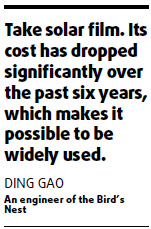Top Biz News
China builds a low-carbon future
(China Daily/Xinhua)
Updated: 2009-12-07 07:52
Beijing's iconic Olympic venue, the Bird's Nest, might have been different if it were built today.
"I would choose to use solar film to power air conditioners in the Bird's Nest instead of the current ground-source heat pump," said Ding Gao, an engineer of the landmark building.

Ding, director of the Building Energy Engineering Center at China Architecture Design and Research Group, said China's promotion of a low-carbon economy has boosted the development and implementation of "green" technology.
"Take solar film. Its cost has dropped significantly over the past six years, which makes it possible to be widely used," Ding said at the recently held First World Low-Carbon and Eco-Economy Conference and Technical Exposition in Nanchang, the capital of East China's Jiangxi province.
Many Chinese entrepreneurs and analysts agreed that low-carbon development has become a trend in China. The trend was propelled by Chinese leaders' commitment to sustainable development.
President Hu Jintao in September told global leaders at the United Nations climate change summit that China will "step up efforts to develop a green economy, a low-carbon economy and a circular economy".
He promised that China would endeavor to cut carbon dioxide emissions per unit of gross domestic product (GDP) by a "notable margin" by 2020 from the 2005 level.
"My company has been trying to change the image of a major energy consumption and polluting enterprise by resorting to environmentally friendly technology," said Zhang Tingke, deputy manager of China Huaneng Group (CHNG), a major State-owned energy enterprise with an installed capacity of more than 9,000 megawatts.
Zhang said all of CHNG's coal-fueled power plants will achieve desulphurization by the end of 2010.
"We are now restructuring the enterprise," he said. "The percentage of clean power, including bio-energy and nuclear power, has been on the rise. The installed capacity of clean energy could reach 33 percent by 2010."
Zhang's company is one of several following the low-carbon trend.
| ||||
His company adopted a "Green Action Plan" that included low-carbon technologies and resource conservation, Li said.
As a sign of the low-carbon fervor, the three-day World Low-Carbon and Eco-Economy Conference, which ended last month, attracted 500 enterprises from 25 countries and more than 1,300 government officials, business executives, foreign ambassadors and international organization representatives.
Despite positive reactions from the public and industrial sectors, Chinese energy experts warned that China's road to industrialization through a low-carbon path would be difficult.
A report issued in September by more than 100 Chinese energy experts said China might reduce the intensity of carbon dioxide emissions with a persistent policy.
"Without long-term substantive technology transfers and financial support from abroad, it will be difficult for China to significantly reduce total carbon dioxide emissions," the report said.
The Jiangxi provincial government announced during the conference that the province would cooperate with the government of Finland to build a low-carbon eco-city in Gongqing city by Poyang Lake, China's largest freshwater lake. The project will begin next year.
"China's urbanization process will bring millions of rural people into the cities. How to build cities for sustainable development is a challenge to China," said Mauri Tommila, whose company, Finland's DigiEcoCity iLtd, is participating in the eco-city project.













